Potřebujeme váš souhlas k využití jednotlivých dat, aby se vám mimo jiné mohly ukazovat informace týkající se vašich zájmů. Souhlas udělíte kliknutím na tlačítko „OK“.
ASTM D6391-11
Standard Test Method for Field Measurement of Hydraulic Conductivity Using Borehole Infiltration
Automaticky přeložený název:
Standardní zkušební metoda pro pole měření hydraulické vodivosti pomocí vrtu infiltrace
NORMA vydána dne 1.11.2011
Informace o normě:
Označení normy: ASTM D6391-11
Poznámka: NEPLATNÁ
Datum vydání normy: 1.11.2011
Kód zboží: NS-34949
Počet stran: 16
Přibližná hmotnost: 48 g (0.11 liber)
Země: Americká technická norma
Kategorie: Technické normy ASTM
Kategorie - podobné normy:
Zařízení pro vrtání a rubání
Geologie. Meteorologie. Hydrologie
Anotace textu normy ASTM D6391-11 :
Keywords:
horizontal hydraulic conductivity, in-place hydraulic activity, vertical hydraulic conductivity, Coefficient of permeability, Field testing--ground water/aquifers, Flow and flow rate--water, Horizontal hydraulic conductivity, Hydraulic conductivity/transmissivity, In-place hydraulic conductivity, Soil, TEG (temperature effect guage), Vertical hydraulic conductivity, ICS Number Code 07.060 (Geology. Meteorology. Hydrology), 73.100.30 (Equipment for drilling and mine excavation)
Doplňující informace
| Significance and Use | ||||||||||||||||
|
This test method provides a means to measure the hydraulic conductivity of isotropic materials and the maximum vertical and minimum horizontal hydraulic conductivities of anisotropic materials, especially in the low ranges associated with fine-grained clayey soils, 1×10–7 m/s to 1×10–11 m/s. This test method is useful for measuring liquid flow through soil hydraulic barriers, such as compacted clay barriers used at waste containment facilities, for canal and reservoir liners, for seepage blankets, and for amended soil liners, such as those used for retention ponds or storage tanks. Due to the boundary condition assumptions used in deriving the equations for the limiting hydraulic conductivities, the thickness of the unit tested must be at least 600 mm. This requirement is increased to 800 mm if the material being tested is underlain by a material that is far less permeable. The soil layer being tested must have sufficient cohesion to stand open during excavation of the borehole. This test method provides a means to measure infiltration rate into a moderately large volume of soil. Tests on large volumes of soil can be more representative than tests on small volumes of soil. Multiple installations properly spaced provide a greater volume and an indication of spatial variability. The data obtained from this test method are most useful when the soil layer being tested has a uniform distribution of hydraulic conductivity and of pore space and when the upper and lower boundary conditions of the soil layer are well defined. Changes in water temperature can introduce errors in the flow measurements. Temperature changes cause fluctuations in the water levels that are not related to flow. This problem is most pronounced when a small diameter standpipe or Marriotte bottle is used in soils having hydraulic conductivities of 5×10–10 m/s or less. The effects of temperature changes and other environmental perturbations are taken into account using a temperature effect gauge (TEG), which is an identical installation with a watertight seal at the bottom of the casing. If the soil being tested will later be subjected to increased overburden stress, then the hydraulic conductivities can be expected to decrease as the overburden stress increases. Laboratory hydraulic conductivity tests or these tests under varying surface loads are recommended to study the influence of level of stress on the hydraulic properties of the soil (8). Note 1—The quality of the result produced by this standard is dependent on the competence of the personnel performing it, and the suitability of the equipment and facilities used. Agencies that meet the criteria of Practice D3740 are generally considered capable of competent and objective testing/sampling/inspection/etc. Users of this standard are cautioned that compliance with Practice D3740 does not in itself assure reliable results. Reliable results depend on many factors; Practice D3740 provides a means of evaluating some of those factors. |
||||||||||||||||
| 1. Scope | ||||||||||||||||
|
1.1 This test method covers field measurement of hydraulic conductivity (also referred to as coefficient of permeability) of porous materials using a cased borehole technique. When isotropic conditions can be assumed and a flush borehole is employed, the method yields the hydraulic conductivity of the porous material. When isotropic conditions cannot be assumed, the method yields limiting values of the hydraulic conductivity in the vertical direction (upper limit) if a single stage is conducted and the horizontal direction (lower limit) if a second stage is conducted. For anisotropic conditions, determination of the actual hydraulic conductivity requires further analysis by qualified personnel. 1.2 This test method may be used for compacted fills or natural deposits, above or below the water table, that have a mean hydraulic conductivity less than or equal to 1×10–5 m/s (1×10–3 cm/s). 1.3 Hydraulic conductivity greater than 1×10–5 m/s may be determined by ordinary borehole tests, for example, U.S. Bureau of Reclamation 7310 (1) ; however, the resulting value is an apparent conductivity. 1.4 For this test method, a distinction must be made between “saturated” (Ks) and “field-saturated” (Kfs) hydraulic conductivity. True saturated conditions seldom occur in the vadose zone except where impermeable layers result in the presence of perched water tables. During infiltration events or in the event of a leak from a lined pond, a “field-saturated” condition develops. True saturation does not occur due to entrapped air (2). The entrapped air prevents water from moving in air-filled pores, which may reduce the hydraulic conductivity measured in the field by as much as a factor of two compared with conditions when trapped air is not present (3). This test method develops the “field-saturated” condition. 1.5 Experience with this test method has been predominantly in materials having a degree of saturation of 70 % or more, and where the stratification or plane of compaction is relatively horizontal. Its use in other situations should be considered experimental. 1.6 As in the case of all tests for hydraulic conductivity, the results of this test pertain only to the volume of soil permeated. Extending the results to the surrounding area requires both multiple tests and the judgment of qualified personnel. The number of tests required depends on among other things: the size of the area, the uniformity of the material in that area, and the variation in data from multiple tests. 1.7 The values stated in SI units are to be regarded as the standard unless other units specifically are given. By tradition in U.S. practice, hydraulic conductivity is reported in cm/s although the common SI units for hydraulic conductivity are m/s. 1.8 All observed and calculated values shall conform to the guide for significant digits and rounding established in Practice D6026. 1.8.1 The procedures in this standard that are used to specify how data are collected, recorded, and calculated are regarded as the industry standard. In addition, they are representative of the significant digits that should generally be retained. The procedures do not consider material variation, purpose for obtaining the data, special purpose studies, or any considerations for the objectives of the user. Increasing or reducing the significant digits of reported data to be commensurate with these considerations is common practice. Consideration of the significant digits to be used in analysis methods for engineering design is beyond the scope of this standard. 1.9 This standard does not purport to address the safety concerns, if any, associated with its use. It is the responsibility of the user of this standard to establish appropriate safety and health practices and determine the applicability of regulatory limitations prior to use. This test method does not purport to address environmental protection problems, as well. |
||||||||||||||||
| 2. Referenced Documents | ||||||||||||||||
|
Podobné normy:
Historická
1.7.2013
Historická
15.9.2012
Historická
1.9.2012
Historická
1.4.2009
Historická
1.5.2012
Historická
1.7.2008
Odebírejte informace o nově vydaných normách ZDARMA:
Chcete pravidelně odebírat informace o nově vycházejících normách z celého světa a to zcela zdarma?
Přihlašte se k odběru. Vše je velice jednoduché a absolutně ZDARMA.
Na výběr máte vydavatele z celého světa.


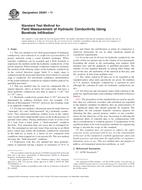
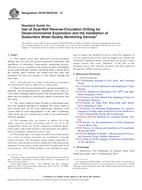 ASTM D5781/D5781M-13..
ASTM D5781/D5781M-13..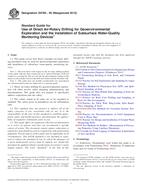 ASTM D5782-95(2012)..
ASTM D5782-95(2012)..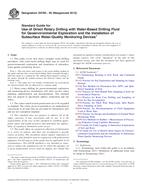 ASTM D5783-95(2012)..
ASTM D5783-95(2012)..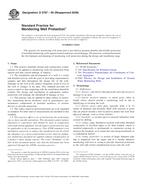 ASTM D5787-95(2009)..
ASTM D5787-95(2009)..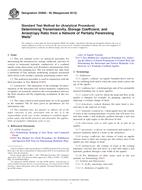 ASTM D5850-95(2012)..
ASTM D5850-95(2012)..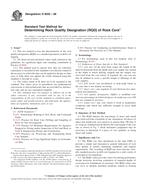 ASTM D6032-08
ASTM D6032-08
 Cookies
Cookies
